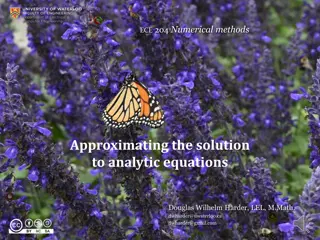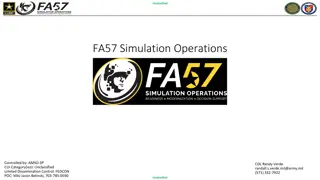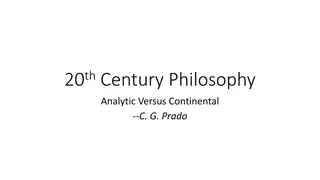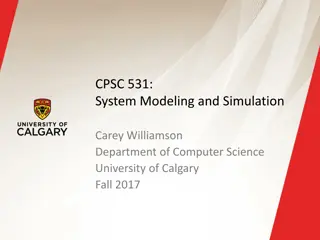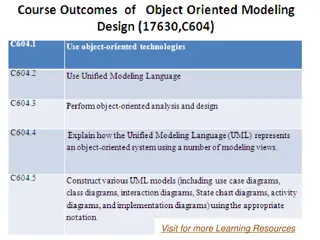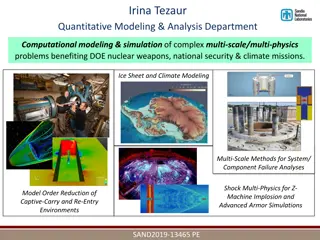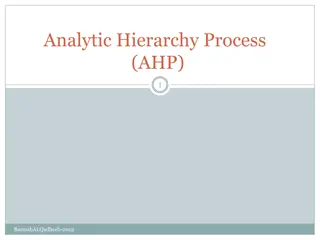Analytic Hierarchy Process for Decision Modeling
Dive into the Analytic Hierarchy Process (AHP) developed by Thomas L. Saaty in the 1970s. Explore how AHP aids in complex decision-making processes with multiple criteria. Learn about modeling problems as hierarchies, conducting pairwise comparisons, deriving weight coefficients, and evaluating priorities. Discover the significance of AHP in group decision-making and solving partial problems efficiently.
Download Presentation

Please find below an Image/Link to download the presentation.
The content on the website is provided AS IS for your information and personal use only. It may not be sold, licensed, or shared on other websites without obtaining consent from the author.If you encounter any issues during the download, it is possible that the publisher has removed the file from their server.
You are allowed to download the files provided on this website for personal or commercial use, subject to the condition that they are used lawfully. All files are the property of their respective owners.
The content on the website is provided AS IS for your information and personal use only. It may not be sold, licensed, or shared on other websites without obtaining consent from the author.
E N D
Presentation Transcript
AHP Modelling of Decision Processess doc. Ing. Pavel enovsk , Ph.D. (Analytic Hierarchy process)
Multi-criteria analysis In the lectures we already discussed the problem in terms of distance of the solution variant to optimum Minimalizing the distance for utility Maximizing the distance to riskiest variant There were multiple limitations to the methods Criteria must be (ideally) independent Interpretation of the connections between the criteria is not considered by MCA Weights derivation is usually not that precise (using pairwise comparison)
AHP (Analytic Hierarchy Process) Developed in 1970s by Thomas L. Saaty Used for Complex decisions with multiple criteria Group decision making Today most widely used method for MCA Its parts are also usable to solve partial problem i. e. derivation of weight coefficients with a way to measure its consistency Multiple software packages exist to help with computation More general form exists ANP (Analytic Network Process), also developer by Saaty
Model problem as a hierarchy decompose the problem into form of hierarchy Evaluate hierarchy pairwise comparison from point of wiev of importance to the problem solution AHP procedure Compute priorities (establish weight system)
Hierarchy Can be as complex as needed Depends on what you actually need to do Choose between known variant? Derive general evaluation system?
Pairwise comparison Scale 1 9 1 equally important 3 moderate importance 5 strong importance 7 very strong importance 9 extreme importance Even numbers can be used for finer distinguishing between the criteria Possible to use 1.1, 1.2, for even finer distinguishing (not binary pairwise comparison) The comparison is performed for each part of the chierarchy
Pairwise comparison 3 groups in our case 1 2 3 4-11 Every leaf node will have it s own group to compare comparison will be between the alternatives
Group 1 Criteria More important Intensity A B Cost Safety A 3 Cost Style A 7 Cost Capacity A 3 Safety Style A 9 Safety Capacity A 1 Style Capacity B 7 Group 1 in matrix Cost Safety Style Capacity Cost 1 3 7 3 Safety 1/3 1 9 1 Style 1/7 1/9 1 1/7 Capacity 1/3 1 7 1
Group 2 Purchase Price Fuel Costs Maintenance Costs Resale Value Purchase Price 1 2 5 3 Fuel Costs 1 2 2 Maintenance Costs 1/5 1 Resale Value 1/3 2 1 Group 3 Cargo capacity Passenger capacity Cargo capacity 1 1/5 Passenger capacity 5 1
To effectively choose variants must be compared (vs leaf nodes of the hierarchy) Various approaches possible use numeric function
Or derive preferences based on complex evaluation
Purchase price - matrix Accord Sedan Accord Hybrid Pilot SUV CR-V SUV Element SUV Odyssey Minivan Accord Sedan 1 9 9 1 5 Accord Hybrid 1 1 1/9 1/9 1/7 Pilot SUV 1 1/9 1/9 1/9 CR-V SUV 1 5 Element SUV 1 6 Odyssey Minivan Fuel costs - matrix 1 Accord Sedan Accord Hybrid Pilot SUV CR-V SUV Element SUV Odyssey Minivan Accord Sedan 1 1/3 5 3 4 3 Accord Hybrid 1 9 5 7 6 Pilot SUV 1 1/3 CR-V SUV 1 2 1 Element SUV 1 1 Odyssey Minivan 1
Maintenance costs - matrix Accord Sedan Accord Hybrid Pilot SUV CR-V SUV Element SUV Odyssey Minivan Accord Sedan 1 2 4 4 4 5 Accord Hybrid 1 4 4 4 5 Pilot SUV 1 1 2 1 CR-V SUV 1 1 3 Element SUV 1 2 Odyssey Minivan Resale value - matrix 1 Accord Sedan Accord Hybrid Pilot SUV CR-V SUV Element SUV Odyssey Minivan Accord Sedan 1 3 4 2 2 Accord Hybrid 1 2 1/5 1 1 Pilot SUV 1 1 1/6 CR-V SUV 1 4 4 Element SUV 1 1 Odyssey Minivan 1
Safety- matrix Accord Sedan Accord Hybrid Pilot SUV CR-V SUV Element SUV Odyssey Minivan Accord Sedan 1 1 5 7 9 1/3 Accord Hybrid 1 5 7 9 1/3 Pilot SUV 1 2 9 1/8 CR-V SUV 1 2 1/8 Element SUV 1 1/9 Odyssey Minivan Style - matrix 1 Accord Sedan Accord Hybrid Pilot SUV CR-V SUV Element SUV Odyssey Minivan Accord Sedan 1 1 7 5 9 6 Accord Hybrid 1 7 5 9 6 Pilot SUV 1 1/6 3 1/3 CR-V SUV 1 7 5 Element SUV 1 1/5 Odyssey Minivan 1
Cargo Capacity - matrix Accord Sedan Accord Hybrid Pilot SUV CR-V SUV Element SUV Odyssey Minivan Accord Sedan 1 1 1/3 Accord Hybrid 1 1/3 Pilot SUV 1 1 1 1/2 CR-V SUV 1 1 Element SUV 1 1/2 Odyssey Minivan Passenger Capacity - matrix 1 Accord Sedan Accord Hybrid Pilot SUV CR-V SUV Element SUV Odyssey Minivan Accord Sedan 1 1 1 3 1/2 Accord Hybrid 1 1 3 1/2 Pilot SUV 1 2 6 1 CR-V SUV 1 3 Element SUV 1 1/6 Odyssey Minivan 1
1 1 ?1 ?1? Weight derivation 1 ? ? ?1 1 ?1? ? = 1 1 We established preference matrix We presume, that the preferences do correspond to true weights ratio of the criteria We can express that as optimalization problem (k is number of evaluated criterions) Leads to problem of quadratic programming which is actualy computationally expensive (and very hard to solve pen & paper) ? ? ? ? 2 ??? ?? ? = ??? ?? ?=1 ?=1
Computing by approximation to geometric mean Only approximation for complex problems such approximation may be not precise enough 1 ? ? ?=1 ??? ??= 1 ? ? ? ?=1 ?=1 ??? ?? =???? ? Evaluate consistency by computing consistency index We can compare the result against random consistency index to compure consistency ratio ? 1
?? Consistency ratio ?? = ???? Random Consistency index k RCI 1 0 2 0 3 0,58 4 0,9 5 1,12 6 1,24 7 1,32 8 1,41 9 1,45 10 1,49 Good value is CR < 0,1 Such CR is usually considered good enough to reject null hypothesis that our computed weights are random
AHP using R ahp package available It supports decision making Does not support establishing weights for hierarchy only Usage: library(ahp) cars <- Load("c:/path/cars.ahp") Calculate(cars) library(data.tree) print(cars, filterFun = isNotLeaf) Analyze(cars) AnalyzeTable(cars)
Input file format YAML YAML Ain t Markup Language Relatively painful to create by hand Structure: The Car example has input file with over 250 lines of code to describe the problem
GUI for YAML file creation https://fbiweb.vsb.cz/~sen7 6/data/uploads/programy/A HPEditor%20v0.1.7z Requires .NET framework Open source (MIT licence) At present time functional under Windows only
Hierarchy creation using GUI
Notes Clicking leaf node check box will allow to directly compare alternatives ahp package allows for usage of functions to derive weights The GUI does not support this feature But is usable to define basic hierarchy and the rest is doable in text editor
Print function prints hierarchy levelName 1 Root 2 --Cost 3 --Purchase Price 4 --Fuel Costs 5 --Maintenance Costs 6 --Resale Value 7 --Safety 8 --Style 9 --Capacity 10 --Cargo Capacity 11 --Passenger Capacity


